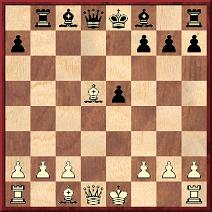
Edward Winter
Below is a pictorial A to Z of chess prodigies up to circa
1950.
The various claims are reported ‘flatly’, i.e. with no
expression of
suspicion or incredulity at any of the more fanciful statements found
in
print over the years. The term prodigy is, moreover,
interpreted here quite loosely, and we have been more inclined to
include ‘older youngsters’ from the nineteenth century than from the
twentieth. First presented in C.N. 3812 (on 3 July 2005), this
directory is expanded from time to time, and any additions,
criticisms or other comments from readers
will be appreciated.
Allen, Richard
C.N. 2845 culled, from page 84 of CHESS, January 1951, a game won by six-year-old Richard Allen against his father:
Richard Allen – Clifford Allen
Normanton, 26 December 1950
Sicilian Defence
1 e4 c5 2 Nf3 Nc6 3 d4 cxd4 4 Nxd4 e6 5 Bb5 Nf6 6 Nc3 e5 7 Nxc6 bxc6 8 Bc4 d5 9 exd5 cxd5 10 Nxd5 Nxd5 11 Bxd5 Rb8

12 O-O (From CHESS: ‘If the near-masters among our readers want to point out that 12 Bxf7+ Ke7 12 Bg5+ would have won Black’s queen, etc., etc., we ask them to remember that White is only six years old.’ However, see below.) 12…Bc5 13 Re1 Qc7 14 Qe2 Bd6 15 Be3 O-O 16 Rad1 Rxb2 17 Rd2 e4 18 Bxe4 Bxh2+ 19 Kf1 f5 20 Bd5+ Kh8 21 c4 Rxd2 22 Qxd2 f4 23 Bd4 Ba6 24 Qd3 Rd8 25 Be5 Qc8 26 Qd4 h6 27 Bxg7+ Kh7 28 Re7 Rg8 29 Qd3+ Qf5 30 Qxf5 mate.
Source: CHESS, January 1951, page 84.
Concerning White’s 12th move, on page 103 of the February 1951 CHESS a reader, T. Harman of Coventry, pointed out the line 12…Kxf7 13 Qxd8 Bb4+ 14 Qd2 Bxd2+ 15 Kxd2 and ‘Black could at least make White’s win difficult’. He concluded that 12 O-O was a good move, and the Editor (B.H. Wood) commented: ‘Several other correspondents similarly put us in our place.’
Ashby, Master
An account of the son of F.L. Ashby of Cheddleton, England, who
learned the moves of chess at the age of three, appeared on
page 40 of the February 1920 BCM. See pages 54-55 of Chess
Explorations.
Baird, Lilian
Lilian Baird (1881-1977) was referred to on page 130 of Kings,
Commoners and Knaves.
An early composition by her was on page 103 of the February 1891 BCM.
Four of her problems were published on page 14 of The Chess Bouquet
by F.R. Gittins (London, 1897), from which the photograph below is
taken:
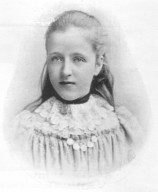
Lilian Baird
C.N. 3818:
Chris Ravilious (Eastbourne, England) reports that in 1995 he brought out a monograph on a prodigy mentioned in C.N. 3812, Lilian Baird, under the title Lilian An Episode in Chess Problem History.
Billikopf, Jacob
Born circa 1882, Jacob Billikopf was featured on page 335 of the November 1897 American Chess Magazine, which praised him highly. See page 130 of Kings, Commoners and Knaves.
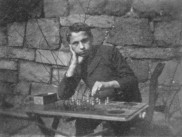
Jacob Billikopf
Blumenschein, Ernest
The conclusion to a game by Ernest Blumenschein against W.H. Smith in Dayton on 25 February 1890 was warmly received by Steinitz on page 155 of the May 1890 International Chess Magazine. Blumenschein was aged 15 at the time. See page 78 of A Chess Omnibus.
Boardman, Harry A.
The problemist Harry A. Boardman (1863-1935) was discussed in C.N. 3410, where several of his compositions as a child were given. He developed into a prominent figure in the problem world. The sketch below was published on page 1374 of the Scientific American Supplement, 25 August 1877.
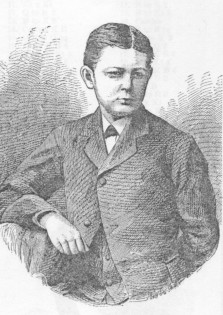
Harry A. Boardman
Božić, Molorad
From page 453 of the November 1934 BCM: ‘Yugoslavia. A new infant chess prodigy has been discovered at Belgrade, Molorad Božić, the six-year-old son of an innkeeper in that city. Though he is already known as “little Alekhine”, it is perhaps best to await developments. Not all Samuel Rechevskis make good as he has done.’
Brereton, Master
A game won by him, at the age of seven, against his father, W.D. Brereton, in Pittsburg in 1898 was given on page 140 of Kings, Commoners and Knaves, from the Philadelphia Public Ledger of 10 February 1898.
Capablanca, José Raúl
A fine set of photographs of the young Capablanca accompanied an article about him by Olga Capablanca on pages 20-37 of Chessworld, May-June 1964. Almost all of his games as a prodigy were published in The Unknown Capablanca by D. Hooper and D. Brandreth (London, 1975). For additional data see our 1989 book on Capablanca, which also contained some rare photographs of the prodigy. Five further specimens are given below:
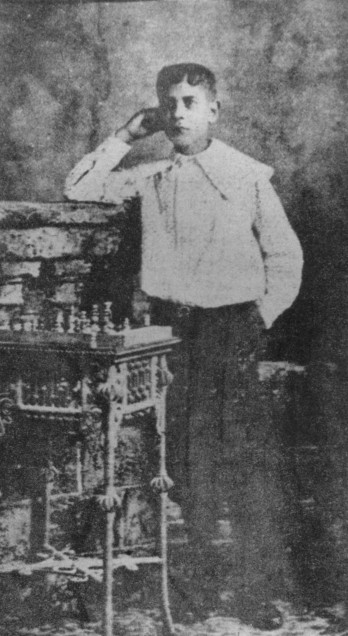
José Raúl Capablanca, aged ten
The next photograph was published on page 142 of El Fígaro, 30 March 1902. Capablanca is standing on the far right during a game between Corzo (Juan or Enrique?) and Manuel Márquez Sterling. Seated from left to right are: José Díaz, Eduardo Delgado, the Marqués de la Gratitud, Ramón Pardo and Gonzalo Herrera.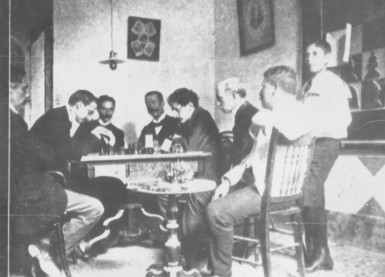
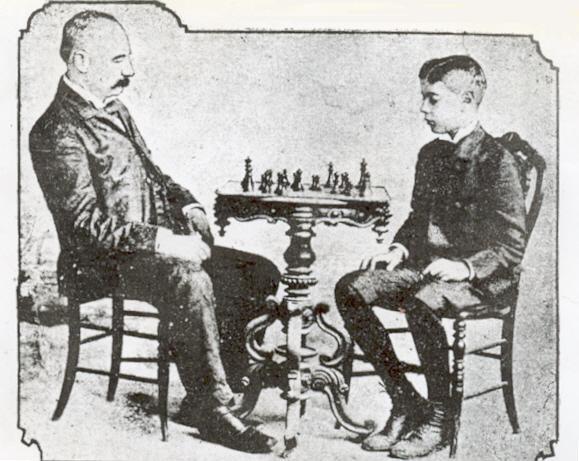
Antonio Fiol and José Raúl Capablanca
The picture below shows members of the Havana Chess Club in the cable match against the Manhattan Chess Club in April 1903: Manuel Márquez Sterling, Antonio Fiol, Enrique Corzo, Juan Corzo, José Antonio Blanco and José Raúl Capablanca.
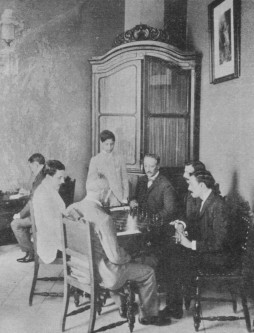

Coyle, Claude H.
The American Chess World of January 1901, page 19 published the following game with the winner’s brief notes and introduced as follows: ‘Played in the second Iowa Correspondence Tournament. C.H. Coyle is only 17 years old and gives promise of being a fine chessplayer.’
Frank Bechley – Claude H. Coyle
Correspondence, circa 1900
Evans Gambit Accepted
1 e4 e5 2 Nf3 Nc6 3 Bc4 Bc5 4 b4 Bxb4 5 c3 Ba5 6 d4 exd4 7 O-O d6 8 cxd4 Bb6 9 Nc3 Na5 10 Bg5 Ne7 11 Bxe7 Qxe7 12 Nd5 Qd8 13 Bd3 Be6 14 Nf4 O-O 15 Re1 Qd7 16 Ng5 Bxd4 17 e5 Bf5 18 e6 fxe6 19 Rxe6 Bxa1 20 Qh5 Bxd3 21 Ng6 h6 22 Ne7+ Qxe7 23 Rxe7 hxg5 24 Qxg5 Bf6 25 Qd5+ Kh8 26 Re3 Bh7 27 Qxa5 Bd4 28 Rf3 Be4 29 Rh3+ Kg8 30 White resigns.
Cross, James
James Cross came to prominence as a 16-year-old, being praised on page 32 of the December 1946 Chess Review. Two of his games were given on pages 125-126 of A Chess Omnibus.
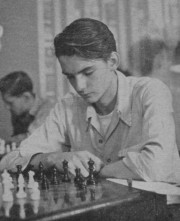
James Cross
Dawson, Cedric
From the American Chess Bulletin, May-June 1927, page 111:
‘In the diminutive person of Cedric Dawson of Lyndhurst, NJ another chess prodigy, 14 years of age, is coming to the front. At any rate, he has been making a distinct impression upon the chess circles of that state and created quite a sensation when, as one of 13 opponents, he was the only one to win a game from Charles Jaffe in a simultaneous exhibition arranged by the Passaic Chess Club at the YMCA of that place on 17 May. A drawn game was scored by Dr William H. Preuss, who, as“Rookookoo”, is conducting a very lively chess department in the Saturday issue of the Passaic Daily News.’
del Sel, Luis Enrique
Page 374 of the October 1921 BCM reported from the
April-June 1921 Revista del Club Argentino de Ajedrez
that Luis Enrique del Sel, born in Santa Rosa on 25 July 1908,
learned chess at the age of nine and was a strong player. See page 55
of Chess Explorations.
Derrickson, George H.
The winner of a famous brilliancy over the board, George H.
Derrickson was also an accomplished problemist. He
died in Philadelphia in 1862 aged about 17. See pages 229-230 of Kings,
Commoners and Knaves and pages 343-344 of A Chess Omnibus.
The photograph of him below (the only one known) is reproduced courtesy
of the Library Company of Philadelphia.

George H. Derrickson
Eaton, Vincent Lanius
Problem composer. See C.N. 4613.
Eichholz, Elliot Franklin
A problem composed by Elliot Franklin Eichholz at the age of five was published on page 132 of the May-June 1917 American Chess Bulletin. See page 234 of Kings, Commoners and Knaves.
Elsner, Max
Page 356 of the November 1885 Deutsche Schachzeitung gave a game Max Elsner won against his mother in Klein Wanzleben on 13 November 1885 when he was six and three-quarters, although, in an unresolved discrepancy, the magazine also stated that he was born on 10 February 1871. See pages 129-130 of Kings, Commoners and Knaves.
Fairhurst, William Albert
A victory by William Albert Fairhurst at the age of 18 against Boris Kostić (Manchester, 1922) was given on page 230 of the Chess Amateur, May 1922 and on page 80 of A Chess Omnibus.
Falk, Dolo
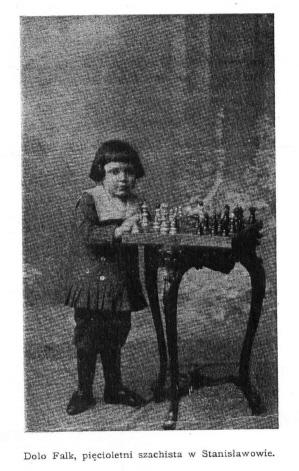
From Stanisławów (born on 17 January 1898). See C.N. 4623.
Fernández, Dionisio R.
Dionisio R. Fernández, aged 15, was featured on page 60 of the February 1929 issue of El Ajedrez Americano with the following game:
Dominguez – Dionisio R. Fernández
Lanús, circa 1928
Scotch Gambit
1 e4 e5 2 Nf3 Nc6 3 d4 exd4 4 Bc4 Bc5 5 Ng5 Nh6 6 Nxf7 Nxf7 7 Bxf7+ Kxf7 8 Qh5+ g6 9 Qxc5 d5 10 Qxd5+ Qxd5 11 exd5 Re8+ 12 Kd1 Nb4 13 Bf4 Nxd5 14 Bg3 c5 15 Na3 Bg4+ 16 f3 Ne3+ 17 Kd2 Bf5 18 Nb5 Nc4+ 19 Kd1 Nxb2+ 20 Kc1 Nc4 21 Nc7
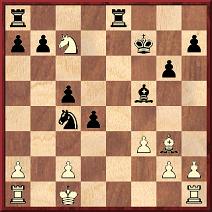
21...Re2 22 Nxa8 Rxc2+ 23 Kd1 Ne3+ 24 Ke1 Bd3 and mate next move.

Dionisio R. Fernández
Fleischman, Simon and Blanca
Pages 52-53 of Chess Explorations quoted from La
Estrategia Mexicana, October 1876 a reference to ‘Miss Blanca
Fleischmann [sic],
the celebrated and distinguished girl from Buffalo in the United
States’, a problemist and player. As noted in C.N. 3402, the chess
column by Sam Loyd in Scientific American Supplement, 19
January 1878 (page 1708) gave a problem by Simon Fleischman and
reported that both
he and his sister had ‘developed a remarkable aptitude for chess and
have published many excellent problems’.
Flores, Rodrigo
Rodrigo Flores was born in Chile in 1913. His activities as a prodigy were presented in C.N. 3046, with four games played in the 1920s.
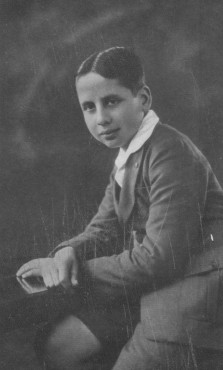

Rodrigo Flores
Graef, Charles and Frederic
A game between these brothers (aged 13 and 14 respectively) in Long Island circa 1857 was given on pages 241-242 of the Chess Monthly, August 1857 and reproduced on page 76 of A Chess Omnibus.
Griffith, William H.
Born on 18 January 1927, a prodigy from Memphis who was
able to set up the 32 chess pieces correctly at the age of two and a
half, according to a report in the Commercial Appeal of 9 March
1930 which was reproduced on
page 84 of the April 1930 American Chess Bulletin. See pages
130-131 of Chess Explorations.
Gromer, Aristide
C.N.s 2945 and 2946 discussed Aristide Gromer (born in 1909), on the basis of reports in La Stratégie, the Chess Amateur, the BCM and the American Chess Bulletin. The score of his loss to V. Kahn in Paris, 1923 was included.
Gueffier
As a 12-year-old he drew against Janowsky in a simultaneous exhibition in Paris (BCM, March 1894, page 89). As mentioned on page 130 of Kings, Commoners and Knaves, it remains to be established whether he was the same player who drew against Emanuel Lasker in Paris in 1909.
Hall, J.
The daughter of W.W. Hall, whom she beat, when she was aged nine, in a game at McGregor, Texas in 1888. It was published in the St John Globe of 20 April 1888 and reprinted on page 77 of A Chess Omnibus.
Hallock, C.G.
For an 1887 reference to C.G. Hallock, see the entry for Wurzburg below.
Johnson, Craig Adams
Page 35 of the American Chess Bulletin, February 1919 stated that at the age of six Craig Adams Johnson of Utica drew his game against Frank Marshall in a simultaneous exhibition.
Keeney, Palmer Gunkel
C.N. 3850:
Neil Brennen quotes from Yenowine’s
Illustrated News, 8 February 1891 an early composition by Palmer
Gunkel Keeney:
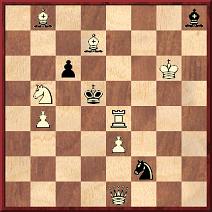
Mate in two.
The News commented:
‘The 13-year-old son of the eminent composer Dr E.W. Keeny. This promising youth embodies all the virtues, strategic instincts and good looks of his illustrious sire.’
Kirkham, J. Henry
When aged 13 J. Henry Kirkham of Newington was mentioned on page 334 of the American Chess Journal, May 1879 as a good player and problem-solver.
Lengden, John
Born in Manchester on 30 October 1902. A biographical note and game were given on pages 119-120 of the March 1912 BCM. See page 54 of Chess Explorations.
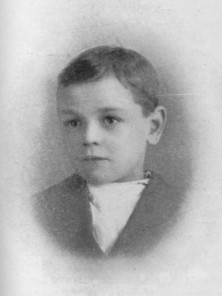
John Lengden
Leonard, James A.
A New York player (1841-1862) notable for his blindfold prowess who was discussed on pages 133-140 of Kings, Commoners and Knaves and pages 93-96 of A Chess Omnibus. A monograph on him by John S. Hilbert was published by McFarland & Company, Inc. in 2006 (C.N. 4087).
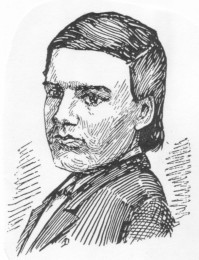
Letelier Martner, René
In the 1930s Chile had a number of strong young players, including René Letelier Martner (born 1915), whose name gained in familiarity when a loss to Fischer was included in My 60 Memorable Games.
The photograph below was published on page 335 of El Ajedrez Americano, November-December 1932:
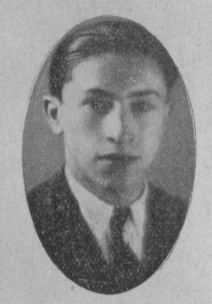
René Letelier Martner
From the same periodical (1932 and 1933 issues) seven early games by Letelier were given in C.N. 3844.
MacLeod, Nicholas
Nicholas MacLeod (1870-1965) was a participant at New York, 1889. An earlier tournament performance of his was highly praised on page 230 of the June 1885 BCM. Jeremy Gaige provided a biography of MacLeod in C.N. 479.
Martínez, Charles S.
Charles S. Martínez (1868-1941) was the son of Dión M. Martínez. A combinational finish to his game against W.E. Wayte in Germantown, 1885 was published by Steinitz on page 153 of the May 1885 International Chess Magazine. See page 78 of A Chess Omnibus.
Mikeladze, Iberie
La Stratégie, 15 August 1885 (page 247) reported that Iberie Mikeladze was an eight-year-old prodigy, the son of Prince Mikeladze. A game of his against Bakradze in Kutais, 1886 was given. See page 76 of A Chess Omnibus.
Mora Iturralde, María Teresa
The Cuban prodigy to whom Capablanca gave lessons, as he reported in My Chess Career. See page 56 of Chess Explorations and pages 122-123 of A Chess Omnibus. Her year of birth is usually given as 1907, but C.N. 3468 discussed the evidence that she was born five years earlier.

María Teresa Mora and Edward Everett (November 1916)
Morphy, Paul Charles
Almost everything known about Morphy as a prodigy is to be found in Paul Morphy The Pride and Sorrow of Chess by D. Lawson (New York, 1976). As far as we are aware, no picture of Morphy as a child has been found.
Muffang, André
A game won by André Muffang (1897-1989) against A. de Poplawski in Paris on 26 March 1913 was published in La Stratégie, April 1913, pages 146-147. See page 79 of A Chess Omnibus.
Nadel, Siegfried
In its report on the Hastings, 1930-31 congress, pages 63-64 of the February 1931 BCM stated that ‘S. Nadel, the 16-year-old boy from Berlin, gave a simultaneous blindfold display against eight players. Most of the games had to be adjudicated, the final figures being: 2 wins, 4 draws and 2 losses. The players who scored wins against him were Mrs Wheelwright and D.A. Breach.’ Page 60 of the same issue recorded that Nadel had finished last in the Major A tournament in Hastings, but: ‘He is only 16 years of age and has been playing chess for only two years. To be a blindfold exponent on such short experience is really remarkable.’
Napier, William Ewart
Comprehensive coverage of William Ewart Napier as a prodigy was provided in Napier The Forgotten Chessmaster by John S. Hilbert (Yorklyn, 1997).
Neimark, Celia
Page 171 of the American Chess Bulletin, September-October
1921
reported that Celia Neimark, aged seven, had defeated the Ohio State
Champion, Irving Spero. The score was reproduced on pages 79-80 of A
Chess Omnibus. The photograph of her below in Cleveland (with an
inverted board) was published on page 206 of the December 1921 issue of
the Bulletin:
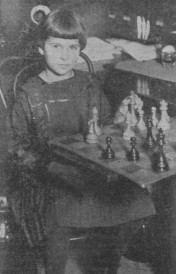
Celia Neimark
Norton, Frank
A problem composer born in 1866 who gained attention in the 1870s. See page 366 of A Chess Omnibus and C.N.s 3402 and 3406 for further information (including problems and games).
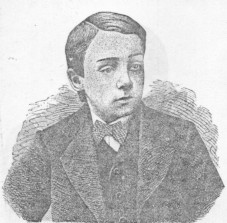
Frank Norton
Pomar Salamanca, Arturo
Born in 1931. The mid-1940s saw the publication of two monographs, Mis Cincuenta Partidas con Maestros (Madrid, 1945) and La Vida de Arturito Pomar by J.M. Fuentes and J. Ganzo (Madrid, 1946). Two specimens of his play were given on pages 114-116 of A Chess Omnibus.
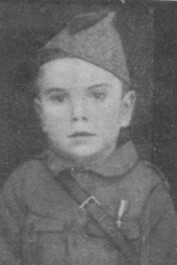
Arturo Pomar, aged five
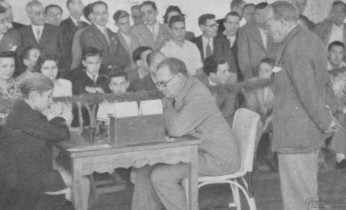
Arturo Pomar in play against Alexander Alekhine, Gijón, July 1944
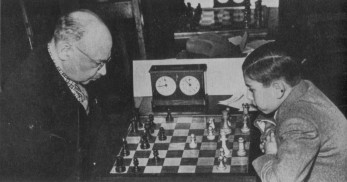
Savielly Tartakower and Arturo Pomar, London, 1946
Pomoschnikov, Pavel
C.N. 3818:
Information is sought on a youngster referred to by Nikolai Grekov in his reminiscences quoted (from where?) by J. du Mont on pages 14-16 of Capablanca’s Hundred Best Games by H. Golombek (London, 1947):
‘The following curious episode took place during the 1936 Moscow tournament. In the interval a 13-year-old schoolboy, Pavel Pomoschnikov, approached Capablanca and in fluent French challenged the ex-champion to a game. Not wanting to distress the boy, Capablanca consented. Having lost three games in succession, Pavel Pomoschnikov demanded a handicap of a queen. Capablanca replied that a queen was too much. The boy then solemnly declared that in ten years he would play against Capablanca as an equal and with better success. The Cuban champion advised the young champion to prepare well for the coming match and presented him with an autographed copy of his book on chess.’
Reed Valenzuela, Enrique
Enrique Reed Valenzuela (1915-1958) of Chile won his country’s championship in 1932. His earliest game known to us is a 50-move loss against Alekhine in a simultaneous exhibition in Santiago on 27 December 1927. The game-score was given on pages 7-8 of Alekhine in Europe and Asia by J. Donaldson, N. Minev and Y. Seirawan (Seattle, 1993), which quoted Alekhine’s remark at the time: ‘Enrique Reed also is a promising youngster, and he showed an excellent temperament’. Alekhine gave him further praise when annotating the game Reed v Danielsson, Buenos Aires, 1939 on pages 73-75 of Gran Ajedrez (Madrid, 1947):
‘One of the very few revelations of the 1939 Buenos Aires Olympiad was Ernst [sic] Reed, the young Chilean (of Germany ancestry) whose style was distinguished by its clear energy and daring attacking conception.’
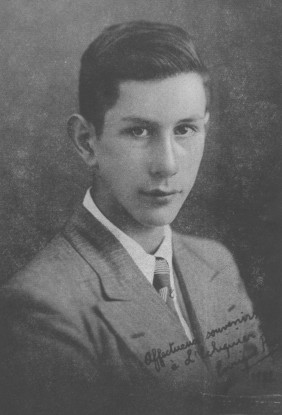
Enrique Reed Valenzuela
The May-June 1932 issue of L’Echiquier had the above portrait, as well as, on pages 1747-1748, four of his games from the 1932 national championship. They were given in C.N. 3843.
Reeve, Birdie
Chessplayer and vaudeville typist. See C.N.s 3572, 3612, 3647, 3668 and 4509.
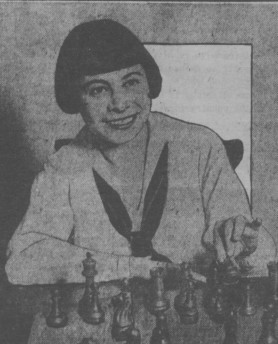
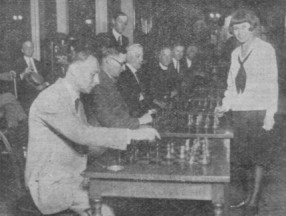
Birdie Reeve
Reshevsky, Samuel
A selection of games played by Reshevsky between 1920 and 1922 was
presented in C.N. 1518 (pages 61-66 of Chess Explorations). For
the most comprehensive collection, see pages 1-19 of Samuel
Reshevsky by Stephen W. Gordon (Jefferson, 1997). An addition was
given on page 98 of A Chess Omnibus (an item based on pages
122-127 of La Stratégie, June 1920). A colourful report
from page 2 of the Boston Post of 4 April 1921 was quoted on
pages 258-259 of Chess Explorations,
which also referred to the claims seen in the
1990s, though seldom since, that Reshevsky was born not in 1911 but in
1909. Below is the title
page of a rare early monograph on the prodigy, published by Bernhard
Kagan in Berlin in 1920:
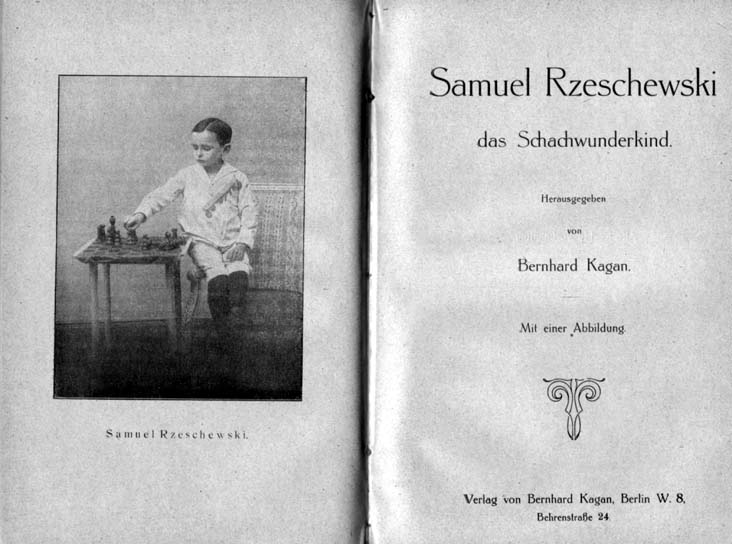
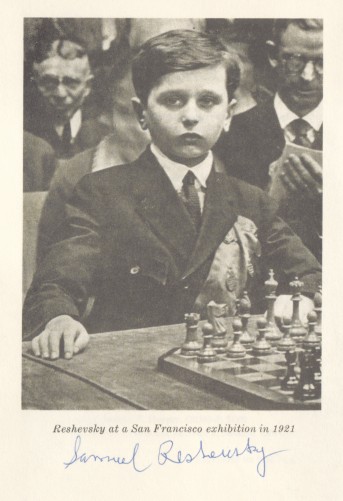
The photograph below was taken before a 20-board simultaneous display by Reshevsky in Cleveland on 27 January 1921:
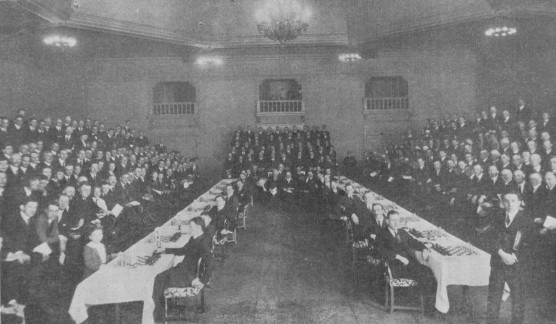
C.N. 3480:
Below are two games by the prodigy which are not in Stephen W. Gordon’s ‘complete games’ collection Samuel Reshevsky:
Samuel Herman Reshevsky – C. Degraeve1 e4 e5 2 f4 Bc5 3 Nf3 d6 4 Bc4 Nc6 5 c3 Nf6 6 d4 exd4 7 cxd4 Bb4+ 8 Bd2 Bxd2+ 9 Nbxd2 O-O 10 d5 Ne7 11 O-O c6 12 dxc6 bxc6 13 Qc2 d5 14 exd5 Bf5 15 Qc3 Nexd5 16 Qd4 Qb6 17 Qxb6 axb6 18 Nd4 Bd7 19 Bb3 Rfe8 20 g3 c5 21 N4f3 Bc6 22 Ne5 Bb7 23 Ndc4 Re7 24 Rfe1 b5 25 Nd6 c4 26 Bd1 Ba6 27 Bf3 Rd8 28 Nf5 Ree8 29 Rad1 Bb7

30 a4 bxa4 31 Nxc4 Rxe1+ 32 Rxe1 Bc8 33 Nfd6 Ba6 34 Rc1 Bxc4 35 Nxc4 Rc8 36 Rc2 Nb6 37 Na3 Rxc2 38 Nxc2 Nc4 39 Kf2 Nxb2 40 Ke2 Nc4 41 Kd3 Nb6 42 Kd4 Kf8 43 Kc5 Nfd7+ 44 Kb4 Ke7 45 Nd4 g6 46 Bc6 f5 47 Bxa4 Nxa4 48 Kxa4 Kd6 49 Kb5 Nf6 50 Nf3 Ne4 51 Kc4 Kc6 52 Kd4 Kd6 53 g4 Ke6 54 h3 Kd6 55 Nh4 Ke6 56 Ng2 Kd6 57 Ne3 Ke6 Drawn.
Source: La Stratégie, June 1920, pages 122-123.
Samuel Herman Reshevsky – M. Billoret1 e4 e6 2 d4 d5 3 e5 c5 4 c3 Nc6 5 Nf3 Nge7 6 Bd3 Ng6 7 O-O cxd4 8 cxd4 Be7 9 a3 O-O 10 g3 Qe8 11 h4 f6 12 Re1 f5 13 Kg2 f4 14 h5 Nh8 15 Bxf4 Rxf4 16 gxf4 Qxh5 17 Rh1 Qg4+ 18 Kf1 Ng6 19 Nc3 Bd7 20 Bxg6 Qxg6 21 Ne2 Qg4 22 Qd3 h6 23 Rg1 Qh3+ 24 Ke1 Rf8 25 Kd2
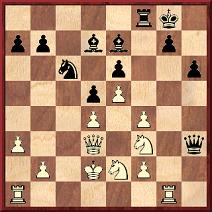
25...Bg5 26 Nxg5 Qxd3+ 27 Kxd3 hxg5 28 Rxg5 Ne7 29 Rag1 Nf5 30 Ng3 Nxg3 31 fxg3 Bb5+ 32 Kd2 Rc8 33 Rc1 Rf8 34 Rc7 Rf7 35 Rxf7 Kxf7 36 f5 Bd7 37 fxe6+ Bxe6 38 Rh5 Kg8 39 Rh1 Bd7 40 Rc1 Bc6 41 b4 Kf7 42 b5 Resigns.
Source: La Stratégie, June 1920, page 126.
A third game from the French magazine,
against L. Schwarz, was given in C.N. 2472 (see page 98 of A Chess
Omnibus). However, that earlier item was incorrect to say that
a fourth game in La Stratégie (a 70-move win against
A. Silbert) was absent from Stephen W. Gordon’s book. We also add here
that page 121 of the June 1920 issue of La Stratégie
reported that on 20 June Reshevsky had played 14 lightning games
(lasting an average of two minutes each) against E. Antoniadi, winning
with
a score of +12 –1 =1.
Still on the subject of Reshevsky, the photograph below, taken at the Hotel Breslin, New York on 27 February 1922, was published on page 44 of the March 1922 American Chess Bulletin:

The caption states, ‘William F. Drueke of Grand Rapids is shown in the center and the sturdy back of Referee Katz is very much in evidence’.
Roberts, John Drew
John Drew Roberts (1864-1931) was discussed, with several specimens of his play, on pages 131-133 of Kings, Commoners and Knaves. For a further example, see page 77 of A Chess Omnibus.
Rohner, W.A.
W.A. Rohner of Hamilton, Australia was mentioned
on page 149 of La Stratégie, April-May 1879 and page 334
of the American Chess Journal, May 1879 as a 12-year-old who
had won a local tournament.
Rolfe, William J.
A photograph of William J. Rolfe Jr., taken when he was aged three, appeared on page 39 of the February 1932 American Chess Bulletin. See also page 143 of A Chess Omnibus.
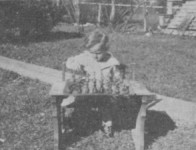
William J. Rolfe
Salot, Henry
A six-and-a-half-year-old prodigy from Philadelphia, according to a report on page 275 of the August 1916 BCM, taken from L’Eco degli Scacchi. See page 54 of Chess Explorations.
Saunders, Elaine
Born in 1926, Elaine Saunders was a celebrated prodigy in the 1930s, and her exploits were well documented in British chess periodicals of the time. On 29 February 1952 she married the chess writer David Brine Pritchard (CHESS, April 1952, page 129).

Elaine Saunders

Elaine Saunders and Vera Menchik
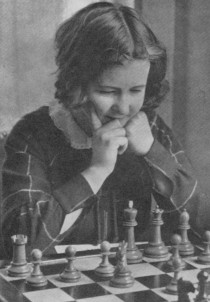
Elaine Saunders
C.N. 3817:
‘She’s a genius.’ That was Alekhine’s observation on the 12-year-old Elaine Saunders after playing her in a simultaneous exhibition in London on 22 January 1938. From page 190 of CHESS, 14 February 1938:
‘Dr Alekhine was televised by the British Broadcasting Corporation in January, “lookers-in” seeing him make, once again, the move which regained for him the world’s championship.
On 22 January he played simultaneously against 30 of Kent’s strongest players and after four and a half hours had won all but three ... Twelve-year-old Elaine Saunders, British girl champion, covered herself with glory by holding out to the very end, succumbing in a rook-and-pawn endgame in the very last game to finish. Dr Alekhine, speaking afterwards, said, “She’s a genius”.
... [Elaine Saunders] became famous overnight – as far as the general public was concerned – as a result of her fine show against Alekhine. Pictures of her with eye to a telescope, boxing a punchball, walloping her father blindfold, etc. were published in many of the daily papers.’
A photograph (featuring Alekhine in play against R.C. Noel-Johnson, Elaine Saunders, C. Chapman, H.H. Cole, H. Israel and W.J.E. Yeeles) of the display at the Charing Cross Hotel, London was published on page 115 of the March 1938 BCM:
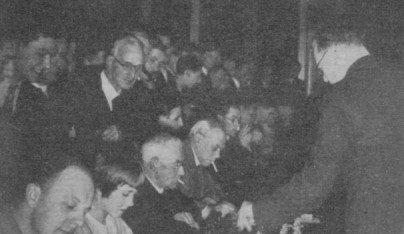
We have never seen the moves of her game against Alekhine, but below is a victory she scored in a simultaneous display given by another eminent figure:
Rudolf Spielmann – Elaine Saunders
Occasion?
Sicilian Defence
1 e4 c5 2 Nf3 Nc6 3 d4 cxd4 4 Nxd4 d6 5 c4 Nf6 6 Nc3 g6 7 Be2 Bg7 8 Be3 O-O 9 Nxc6 bxc6 10 h4 Qa5 11 Qd2 Ng4
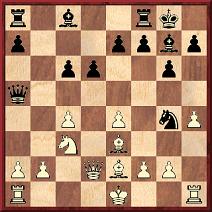
12 h5 Nxe3 13 Qxe3 Qb4 14 Qd2 Be6 15 hxg6 fxg6 16 a3 Qc5 17 O-O-O Rxf2 18 b4 Qe5 19 White resigns.
This score is taken from a feature on Elaine Saunders on pages 263-264 of the Australasian Chess Review, 31 October 1938, which commented:
‘We do not intend to wallow in newspaper sensationalism about this little champion. Our readers will be more interested in the following remarks made by her father, Mr H. de B. Saunders, in response to our request for Elaine’s photo.
“I should like to stress the point that despite the reports of the ‘sensational press’ Elaine is quite an ordinary child, and not a ‘prodigy’. She is fond of all outdoor sports, and is especially keen on swimming, riding, skating and ball games. All the same, she has chess to thank for making innumerable friends both at home and abroad. She is playing three sets of correspondence chess with German opponents at the moment; all of whom are otherwise quite unknown to her.
Her successes have been almost entirely due to the kind and patient coaching of our friend Mr C.D. Locock (whose Imagination in Chess you have reviewed in the ACR). Although a veteran, Mr Locock still finds time to visit girls’ schools and teach chess; his service in this direction being entirely voluntary. Without his help, Elaine would never have risen above the ranks of ‘woodshifters’ and she bears him a considerable debt of gratitude.”’
Below is the illustration which accompanied the article in the Australasian Chess Review:
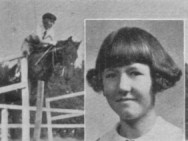
Elaine Saunders
In 1939 P.W. Sergeant dedicated to her his book An Introduction to The Endgame at Chess, as follows:
‘Dedicated to Miss Elaine Zelia Saunders because she doesn’t (at present) like the Endgame.’
We wonder if any other chess book has been dedicated to somebody as young as 13.
C.N. 3826:
Elaine Saunders gave an account of her game against Alekhine on page 224 of British Chess by G.S. Botterill, D.N.L. Levy, J.M. Rice and M.J. Richardson (Oxford, 1983):
‘The incident which received the most publicity was the “affair Alekhine”. Most of the pre-war giants were kindly if a little condescending towards me but the new world champion – he had just regained the title from Euwe – showed me no mercy. He took on 30 Kent players at the Charing Cross Hotel and after five hours demolished all except myself. [In fact, Alekhine’s final score was +27 –2 =1.] The ending was equal. He stood over our board and glowered. “Give the child a draw”, said someone in Russian in the audience, which despite the midnight hour were everywhere on chairs and even under tables. “I know what I am doing”, came the reply, and of course he did. I lost.’
Solomon, Abie
Born in Minsk on 23 December 1892 and emigrated to the USA circa 1897. An account of his chess play from the St Louis Globe-Democrat was published on pages 15-16 of the November-December 1906 issue of Lasker’s Chess Magazine. He was active in the San Antonio Chess Club in Texas.
Spalding, F.S.L.
A prodigy solver from Plymouth, England who was discussed on page 142 of the March 1902 BCM. See page 54 of Chess Explorations.
Stella, Mademoiselle
An account was published on page 177 of La Stratégie,
15 June 1895. See C.N. 3145.
Sumar, Julio
Born in 1932, Julio Sumar (from Peru) was discussed, with an illustrative game, on page 254 of the August 1947 BCM. See pages 55-56 of Chess Explorations.
Thompson, C.
On page 219 of the July 1890 International Chess Magazine Steinitz published a game won by C. Thompson against J.D. Elwell in Brooklyn, 1890. Thompson was aged 18. See pages 78-79 of A Chess Omnibus.
Vaux, Leonard
From page 50 of the Columbia Chess Chronicle, 15 September 1889:
‘Leonard Vaux, a youth of 16, who has just graduated from the High School at Brockton, Ont., has beaten all the chessplayers in his neighborhood, and is spoken of as a prodigy.’
Viesca, Andrés Ludovico
Andrés Ludovico Viesca was a Mexican prodigy born in Parras de la Fuente on 8 April 1869. A win against José Martí was published in El Fígaro of 8 October 1893. See pages 52-53 of Chess Explorations.
Wahrburg, David
At the age of 14 David Wahrburg of Stuyvesant High School drew against Capablanca in a simultaneous display at the Manhattan Chess Club, as reported on page 42 of the March 1922 American Chess Bulletin.
White, Robert C.
According to pages 73-75 of the April 1917 American Chess Bulletin, at the age of 12 Robert C. White held Frank Marshall to a draw in a 144-board simultaneous exhibition in Buffalo on 8 March 1917. See page 130 of Kings, Commoners and Knaves.
Woolf, George William
Born in South Hackney, London on 22 October 1893, and the subject of a feature, including a game, on pages 414-415 of the October 1901 BCM. See page 53 of Chess Explorations.
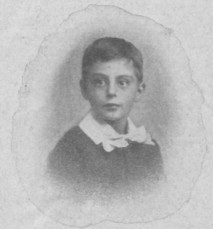
George William Woolf
Wurzburg, Otto B.
C.N. 3850:
Neil Brennen offers the following early mention of O. Wurzburg, in the Denver Republican, 2 October 1887:
‘Master Otto Wurzburg, aged 12, William A. Shinkman’s nephew, is said to possess great talent as a composer, and C.G. Hallock, 13 years of age, took the first prize in the last tournament of the Minnesota Chess Club.’
Zaremba, Paul D.
A photograph of Paul D. Zaremba at the age of 21 months was published on page 39 of the February 1932 American Chess Bulletin. See also page 143 of A Chess Omnibus.

Paul D. Zaremba
‘In his column in the Illustrated London News of 22 November 1856, page 532, Staunton gave the following response to a correspondent, “Septimus”:
“A more remarkable instance of precocious chess genius was the nephew of Mr Pratt (the editor of a well-known edition of “Philidor”). This young Titan, only 15 years of age, at the contest for a prize given by Mr Holford many years ago, entered the arena against the redoubtable Cochrane, then a first-rate player, and was within an ace of carrying off the trophy. We have heard Mr Cochrane admit that it was by the merest accident he saved the match.”
The term “precocious chess play” had been used by Staunton three weeks earlier in an apparent reference to Morphy in the column on page 460 of the 1 November 1856 issue, responding to C.A. Maurian:
“Your communication, dated June, appears to have made a wide circuit. We are glad that at length it has reached its destination, and thank you for the extremely interesting specimen of precocious chess play it contains. If the young Philidor of New Orleans proceeds as he has begun, he will soon rival the oldest and best players of the age.”’
Latest update: 2 January 2007
To the Chess Notes main page.
To the Archives for other feature articles.
Copyright: Edward Winter. All rights reserved.